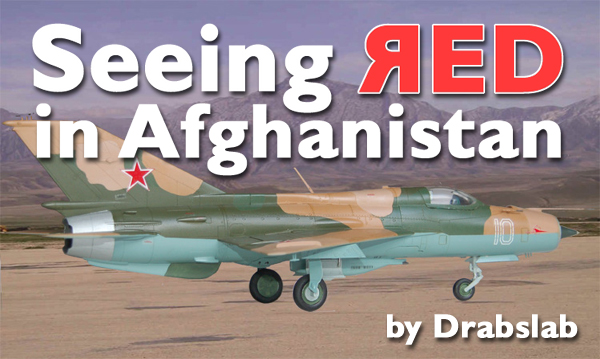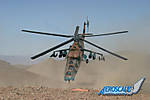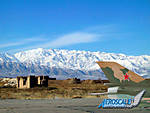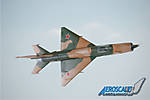1⁄35Seeing Red in Afghanistan
7
Comments

A Christmas surprise
On Christmas night, 1979, the Soviets staged a massive airlift operation involving an estimated 280 transport aircraft moving troops, munitions, and equipment into Afghanistan. The operation continued the following days until three airborne divisions had deployed in Afghanistan.The western world was stunned. Not only were the Soviets able to mobilize +/- 30% of their air fleet (including Aeroflot) and move nearly 26000 men, including artillery and other equipment, to a foreign nation, they also seemed to be able to prepare these massive operations in total secrecy.
It seemed clear in those early days of the Soviet Afghan war that the poorly-organized Afghan opposition was no match for the Soviet troops. The US were already considering the impact of a new Soviet stronghold with a range of new airfields in the western part of Afghanistan that could bring MiG-25 Foxbat reconnaissance aircraft and long-range MiG-27 Flogger fighter-bombers within range of the Strait of Hormuz and the Indian Ocean.
But the Soviets were to be taught the same hard lesson that the US forces learnt earlier in Vietnam. Under the right circumstances, a dedicated and determined rebel force can hurt and continue to hurt even the best-organized and -equipped modern army.
And what may have seemed an easy victory soon turned into a long, exhausting guerilla war. Confronted with an elusive enemy hiding in a wild and vast mountainous area the size of Texas, the Soviet army soon turned to tactics earlier used by the Americans in Vietnam.
The war develops...
The Afghan landscape is characterized by deserts, rugged mountains and steep valleys with isolated villages and a tribal population used to living off the land under the ruling of warlords and the threat of attacks. This is a dream scenario for the guerilla commander, a nightmare for the traditionally-organized Soviet army with complicated decision-taking structures and old-fashioned doctrines.The Soviets tried to bomb the enemy to bits. They used about anything they had to throw bombs at the guerilla's, their villages, their crops and lifestock. Badger (TU-16) bombers, stationed inside the Soviet Union, began high-altitude carpet bombing against guerrilla villages and strongholds in the Panshir Valley. However, many potential targets were protected from these raids by the mountain peaks and those that were not were soon enough moved.
All together, these wild bombing raids had a devastating effect on the population but the military advantage was disputable. A lesson that was already learned, but apparently forgotten, during World War II.
Carpet bombing didnít help the ground troops which were scattered across the country, in many cases in difficult to reach outposts. These outposts were under constant threat. Moreover, it proved to be impossible to supply many of these outposts by unprotected ground convoys while parachute drops were, due to the terrain, difficult and impractical.
The fighter-bombers
So it should come as no surprise that the Soviets built (or improved) several fully operational airports, the most important being Herat, Shindand, Farah, Kandahar, Kabul, Bagram, and Jalalabad. This was a sore sight for the Americans which didn't like the Soviet Union to be capable of handling large numbers of tactical aircraft in Afghanistan which could later be used against other SouthWest Asian countries.The presence of technical support and maintenance capabilities on all airfields allowed Soviet planes to quickly move from base to base as operations required. And there were many operations. At times, more than 100 sorties per day were counted mainly from the Su-17 Fitter, Su-24 Fencer, MIG-21 Fishbed and MiG-23 Flogger.
The jets were employed exclusively in the air-to-ground role, since the Afghan guerrillas offered no air-to-air threat. This varied from carpet bombing, terror bombing, and scorched-earth bombing in efforts to destroy the guerrillas or drive them from the country.
The Fitters and Fishbeds were relegated primarily to missions requiring general accuracy, while the Fencers and the Floggers were used more for direct air support against point targets.
Luckily for the resistance, the jets proved to be ineffective in the air-to-ground role. This was partly because of the inadequate weaponry (reports claim that up to 50% of all bombs did not explode), the high altitude negatively effecting the performance of the jet engines, the terrain which made it very difficult to fly fast jets, and the fact that jets like the MIG-21 were primarily designed for the air to air role.
Another important contributing factor was the Soviet military organization, whose long command chains prevented quick reaction in support of field troops or timely processing of information from outposts or scouts.
The helicopter
The helicopter played a decisive role in the Soviet Afghan war. Estimates vary from 500 to 650 machines of which up to 50% were of the lethal MIL-24 Hind type.While the jets proved to be inadequate in the Afghan mountains and for the role that they needed to play, the Hind, carrying a truckload of missiles under its stubbed wings while at the same time transporting up to 12 soldiers, seemed specially designed for this environment. Its heavy armor made it almost indestructible for small arms fire. It seemed like the Hind could do just anything and soon special tactics were developed to make the most of this formidable weapon.
A standard escort tactic was developed for protecting ground convoys. A number of Hinds would hover over the convoy, searching for potential ambush situations. Troops could be dropped on hills ahead of the convoy. While these soldiers secured the area for the oncoming convoy, the Hinds would stay around protecting the troops they had dropped.
Once the convoy passed the Hinds would pick up the troops and insert them further along the road.
The Hind was also heavily used for search-and-destroy missions. Packs of four and six would search through enemy controlled areas ready to fire at anything alive. Sometimes a single Hind would fly at high altitude, while the rest of the pack was hiding and ready to attack any opponent who opened fire on the sitting duck.
Once a target was spotted, a single Hind at a time would swoop down hovering, firing rockets and machine guns while the others remained flying in a circular pattern around the target.
Another important advantage was that the Hind was an Air Force vehicle able to report directly to the Air Force headquarters. Whereas it took hours to relay a field commander's request for air assistance up to Army headquarters, then to the Air Force headquarters, back to the operational Air Force units, the Hind pilot could directly contact the correct level in the Air Force command structure.
The Frogfoot
This increased responsiveness in a very important way and allowed for maximum use of the newly introduced SU-25 Frogfoot.This close-support aircraft is often compared with the USAF A-10. It can carry up to 10,000 pounds of ordnance on ten stations and deliver these bombs on point targets, even under very difficult circumstances.
The Frogfoot operated in loose pairs, going in separately and very low, making it a difficult target for surface to air fire.
The combination of Hinds with Frogfoots was lethal for the Afghan guerilla forces. Hinds would scout the area, locate the enemy, and "keep them busy" with rocket attacks and machine gun fire. Then the Frogfoots would be called in to drop their ordnance on the clearly marked enemy after which the Hinds would release troops to sweep the area and eliminate anything that was left.
These tactics paid off and slowly the Soviets got a firmer grip on the country.
Times change
But these successes were a thorn in the eye of the US. There were already persistent rumors that the Afghan rebels were "advised" by US Special Forces. Now the US involvement stepped up, and amongst other things, the notorious Stinger, a portable anti-aircraft missile, appeared on the scene.Suddenly, the mighty Hind turned from the hunter into the hunted. This had a huge influence on the Soviet war machine that relied on its helicopter force for a diverse range of tasks like attacking and slowing down the enemy, supporting ground troop movements, scouting and close air support.
The odds shifted and finally, after many years of combat, the Soviets retreated from Afghanistan. Afghanistan was more than ever a political, social and economic waste land and therefore excellent breeding ground for radical ideas. Soon the country fell prey to the extreme religious Taliban which would adopt a social model in which women were treated like cattle, destroy ancient monuments which didn't fit within the regime's beliefs and host terrorist groups.
Lessons learned
The Soviets had most certainly learned many valuable lessons from their war in Afghanistan. While large scale military exercises, Red Flag-style, are extremely valuable to gain experience under "safe" circumstances, real combat against an opponent that doesn't follow the script remains the ultimate test for tactics, personnel and equipment. Most of all they learned first hand that superior technology doesn't solve everything.Western observers reported significant changes to the Soviet tactics during the Afghan conflict, relying more and more on close air support provided by the helicopter force and a considerable improvement in control, communication and command structures.
At a certain moment it was even claimed that the experience gained in Afghanistan and the impact that this had on the organization of the Soviet forces was far more significant than whether the Soviets would win or lose the war. One could wonder what is left of this knowledge now that the Soviet bloc has collapsed.
The western world particularly learned that the Soviets were willing and quite able to successfully deploy heavy forces outside the boundaries of the Soviet Union.
But important issues remain...
The Afghan rebels pounded the Soviet army until it gave up and left, just like they have done before with numerous foreign armies that tried to gain the upper hand in the country.Isn't it ironic that the US assisted in defeating a Communist army which would, only a couple of years later, die a natural death when the Soviet Union fell apart, while at the same time helping to create a terrorist foe which would haunt the western world with guerilla-like strikes?
At present, there are international NATO forces in Afghanistan helping the western-friendly regime to keep rebel forces at bay. A striking similarity with the situation in 1979 when Soviet forces supported the local Communist regime.
I wonder who is going to win this time? Without any negative connotation to those currently serving "Over there" I can only note that both the odds and history seem to be against us. News reports on "the Taliban controlled area" producing record amounts of opium, the basis for heroin and traditional source of income for the local warlords, and on massive NATO offensives against Taliban troops at least indicate that the area is still boiling.
Indeed, times change but some things appear to remain the same.
Disclaimer
It is not possible to completely and accurately describe a conflict with so many facets as the Soviet Afghan war in a few lines. It is, for instance, clear that other airplanes and helicopters played a role besides the ones portrayed above.What I have honestly tried is to communicate the overall impression that I was left with after digging in the pile of available information about this apparently almost forgotten war and to create a context for the presentation of some of the most widely used airplanes during this conflict.
In no way is this article aiming at taking a political or religious position, or at hurting anyone for whatever reason.
Comments
A very interesting and historical feature.
The photo-composites really bring the models to life.
Are there any plans for some more of the same.
Andy
MAY 27, 2007 - 01:52 AM
I don't know if I am going to make more of these.
I made this article as a kind of "thank you" to Kitmaker and a few people here that gave me, in one case very substantial, help to get going again.
I dare to say that it was a lot of work, not only in making 3 model airplanes but mostly in reading information on this conflict and making the article itself sometimes weighing the words on a very precise scale.
Also, the photography and learning how to use photoshop took a huge bite out of my time. All together this project dominated my spare time for almost a year and that is quite an investment.
On the other hand, it was a lot of fun and it does express how making models fits in my general interest for planes, politics... and I do have several ideas for more "uncommon" articles.
So, I guess that it depends on the Aeroscale users themselves.
If people find it interesting to see model airplanes put in a real-life context of any kind then surely, I would feel inclined to make more articles.
If there is no interest in this then I naturally don't see the point to continue producing things that no-one wants to read.
;-)
MAY 30, 2007 - 09:01 PM
Hi Drabslab!
Don't be hard on yourself! I hope you will continue to write such interesting and well researched articles!
As producing things that nobody want to read... why not? I wrote articles that were successfull and other that almost gathered no interest. My Aircraft in Comics episodes usually generate around 600 hits. This is way below the average score of an Aeroscale article. Yours for exemple made 500 so far in 5 days while one of mine made only 600 in 5 months!
But you know what, I will continue to do my Aircraft in Comics serie because I like it and I know some find them interesting. Maybe not many but enough for me. So if you are having fun making your articles, please continue and you will find your readership over the time (I think you already did).
There could have been more feedback in this thread about your article though. But I noticed this is a trend since a few months here at Aeroscale. Articles and On Displays are published but members don't leave messages about them. Maybe our readership is becoming more and more passive and less active. A lot of people read the articles but don't participate anymore. Is this good or is this bad, I don't know, but we live in a consumers world I'm afraid...
Jean-Luc
MAY 31, 2007 - 01:20 AM
Thanks for the article - I've read it with interest
I don't agree with some of your conclusions though. For instance I can't say that russians "gave up" and retreat... and I definitly can't say that they "lost the war". You wouldn't probably say that americans lost the war in Vietnam, would you? It all depends on a point of view...
But you are right - too bad this war is allmost forgotten now aswell as its veterans.
MAY 31, 2007 - 05:56 PM
Thank you for the well-written article on an interesting subject, and for the photos. But I have a question: Did any of the Soviets' Warsaw Pact allies participate in the Afghanistan War?
NOV 17, 2007 - 04:38 AM
Sorry for the late reply, I only recently noticed that there was a question.
As far as I know this was a Soviet Union invasion only (please correct me if I am wrong) and there was no active (or publically known?) involvement of the other Warsaw Pact members.
The Warsaw pact was started as a reaction to the establishment of NATO with more or less the same ambitions and more or less using the same model. Its primary (official) aim was for the members to support each other when being attacked by a third country.
By 1979 the Warsaw Pact had already suffered badly from internal difficulties like the invasion by the soviets of Hungary and Czechoslowakia. This had caused various members of the pact to withdraw or openly criticise the actions of the soviets.
Hence, I assume that the members of the Warsaw Pact would not have been very enthousiastic to help invading a third country on basis of a treaty that was not covering such actions in the first place. Moreover, the polish "solidarnosc" union movement that gained momentum around 1979-1980 was openly distanciating itself from the Soviets. Forcing the Warsaw Pact members to participate in the Afghan war could have forced other members to join this "new rebellion".
DEC 20, 2007 - 01:50 AM
Copyright ©2021 by AeroScale. Images also by copyright holder unless otherwise noted. The views and opinions expressed herein are solely the views and opinions of the authors and/or contributors to this Web site and do not necessarily represent the views and/or opinions of AeroScale, KitMaker Network, or Silver Star Enterrpises. Images also by copyright holder unless otherwise noted. Opinions expressed are those of the author(s) and not necessarily those of AeroScale. All rights reserved. Originally published on: 2007-05-27 00:00:00. Unique Reads: 10338




























